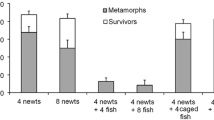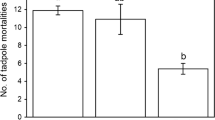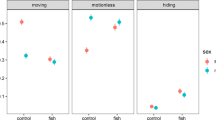Abstract.
The introduction of fish has decimated many amphibian populations through increased predation, primarily on their larvae. Some amphibian species now occupy marginal habitats as a response to the presence of introduced fish predators. Such habitats may include ephemeral water bodies where fish do not usually occur, although breeding in these suboptimal environments may incur some cost to a species if its larvae are not adapted to develop under these conditions. We investigated this scenario of amphibian decline using the endangered green and golden bell frog (Litoria aurea) and the introduced mosquitofish (Gambusia holbrooki) in a factorial experiment to determine the responses of tadpoles to declining water levels and the introduced predator. Tadpoles metamorphosed asynchronously but did not accelerate development in declining water or when housed with mosquitofish. Mass at metamorphosis was 30% less in declining water. Mass increased with time to metamorphosis in constant water-level treatments, but decreased in declining water. Tadpoles did not respond to mosquitofish and were therefore assumed to be naive to this predator. These results suggest that ephemeral habitats may be suboptimal for breeding, and tadpoles appear better suited to develop in permanent water bodies free of introduced fish. Intra-clutch variability in larval development (i.e. bet-hedging) may allow L. aurea to cope with unpredictable pond duration, whereby even permanent water bodies may occasionally dry out. The responses observed in L. aurea suggest that introduced fish may have reduced the suitability of permanent water bodies as breeding sites for other pond-breeding amphibian species. The use of less favourable ephemeral habitats as breeding sites may be responsible for some of the declines reported in amphibians since the 1970s.
Similar content being viewed by others
Author information
Authors and Affiliations
Corresponding author
Additional information
Electronic Publication
Rights and permissions
About this article
Cite this article
Hamer, A., Lane, S. & Mahony, M. The role of introduced mosquitofish (Gambusia holbrooki) in excluding the native green and golden bell frog (Litoria aurea) from original habitats in south-eastern Australia. Oecologia 132, 445–452 (2002). https://doi.org/10.1007/s00442-002-0968-7
Received:
Accepted:
Published:
Issue Date:
DOI: https://doi.org/10.1007/s00442-002-0968-7




